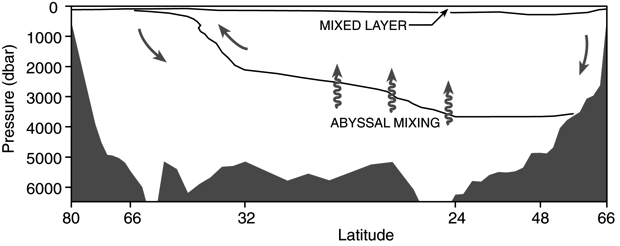OCEAN ENERGETICS
The coexistence in the deep ocean of a finite, stable stratification, a strong meridional overturning circulation, and mesoscale eddies raises complex questions concerning the circulation energetics. In particular, small-scale mixing processes are necessary to resupply the potential energy removed in the interior by the overturning and eddy-generating process. A number of lines of evidence, none complete, suggest that the oceanic general circulation, far from being a heat engine, is almost wholly governed by the forcing of the wind field and secondarily by deep water tides. In detail however, the budget of mechanical energy input into the ocean is poorly constrained. The now inescapable conclusion that over most of the ocean significant “vertical” mixing is confined to topographically complex boundary areas implies a potentially radically different interior circulation than is possible with uniform mixing. Whether ocean circulation models, either simple box or full numerical ones, neither explicitly accounting for the energy input into the system nor providing for spatial variability in the mixing, have any physical relevance under changed climate conditions is at issue.

Selected references
Ferrari, R., and C. Wunsch, 2010: The distribution of eddy kinetic and potential energies in the global ocean, Tellus A, Vol. 62, 92-108.
Ferrari, R. and C. Wunsch, 2008: Ocean Circulation Kinetic Energy–Reservoirs, Sources and Sinks, Ann. Rev. Fluid Mech., Vol. 41, 253-314.
Wunsch, C., and R. Ferrari, 2004: Vertical Mixing, Energy, and the General Circulation of the Oceans, Ann. Rev. Fluid Mech., Vol. 36, 281-314.


